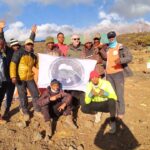Climb Kilimanjaro with Asthma: A Comprehensive Guide
Can You Climb Kilimanjaro with Asthma? Absolutely, Yes!
If you’re wondering whether it’s possible to climb Kilimanjaro with asthma, the answer is a resounding yes. Many people with asthma have successfully reached the summit of Mount Kilimanjaro, the tallest peak in Africa and the largest free-standing mountain in the world. However, climbing Kilimanjaro with asthma requires careful preparation and understanding of your condition.
Understanding Asthma and High Altitude
Mount Kilimanjaro’s altitude is no small feat, with the summit reaching over 19,000 feet. The question often arises: is it really possible to climb Kilimanjaro with asthma? The key lies in understanding the type and severity of your asthma, as well as the challenges presented by high altitudes.
Before embarking on your adventure, it’s crucial to consult with your doctor to determine how your asthma might be affected by the high altitude. This step is essential for planning a successful and safe climb.
High Altitude and Asthma: What to Expect
When you climb Kilimanjaro with asthma, you’ll encounter five distinct ecological zones, each with varying altitudes and climatic conditions. As you ascend, the oxygen levels decrease, and the air becomes colder and drier, which can dry out the mucus membranes lining the lungs, potentially triggering asthma symptoms.
Kilimanjaro Asthma Tips:
- Cover your respiratory passages: Wearing a mask or scarf can help warm the cold air before it enters your lungs.
- Keep your inhaler warm: Store it close to your body and rub it between your palms before using it.
- Stay hydrated: Drinking plenty of water helps maintain the moisture in your airways.
- Avoid strenuous activity: Pace yourself, especially at higher altitudes, to avoid overexertion.
- Always carry your asthma medication: Ensure you have quick access to your inhaler and any other prescribed medications.
Preparing for the Climb: Asthma-Specific Precautions
Proper preparation is key to a successful Kilimanjaro climb with asthma. Here’s what you need to do:
1. Medical Clearance:
- Obtain a fitness clearance from your doctor after a thorough medical check-up. This step is non-negotiable for climbers with asthma.
2. Practice Breathing Exercises:
- Engage in cardiovascular and breathing exercises to strengthen your respiratory system. This preparation can make a significant difference when you face the challenges of high altitude.
3. Monitor Your Reaction to Higher Elevations:
- If possible, test how your body responds to higher altitudes before your Kilimanjaro climb. Visit nearby high-altitude locations and observe your breathing and heart rate.
Managing Asthma at High Altitude
High altitude brings unique challenges, but it’s essential to understand that asthma and altitude sickness are different conditions. Climbing Kilimanjaro with asthma doesn’t necessarily increase your risk of altitude sickness, but being aware of both is crucial.
Altitude Sickness Symptoms:
- Headache
- Dizziness
- Weakness
- Nausea
- High heart rate
If you experience these symptoms, it’s essential to stop, rest, and hydrate. Severe symptoms, such as difficulty breathing at rest, chest tightness, or coughing, require immediate descent to a lower altitude.
Types of High Altitude Sickness:
- Acute Mountain Sickness (AMS)
- High Altitude Pulmonary Edema (HAPE)
- High Altitude Cerebral Edema (HACE)
Tips for a Successful Climb with Asthma
To ensure a safe and successful Kilimanjaro climb with asthma, follow these tips:
- Acclimatize Slowly: Take your time to acclimatize as you ascend. Choose a longer route that allows your body to adjust gradually.
- Sleep at Lower Altitudes: If possible, descend slightly to sleep after a day of climbing to help your body recover.
- Go at Your Own Pace: A slow and steady pace is key to conserving energy and reducing asthma flare-ups.
- Stay Warm: Wear appropriate clothing, especially a warm and puffy jacket, to protect yourself from the cold.
- Maintain Fitness: Regularly engage in fitness activities and smaller hikes before attempting Kilimanjaro to build your endurance.
- Insurance: Obtain trekking insurance that covers asthma and other pre-existing conditions.
- Emergency Plan: Carry an asthma attack card and share it with your climbing team, so they are aware of how to assist in an emergency.
Final Thoughts: Climbing Kilimanjaro with Asthma
With proper preparation, determination, and awareness, it is entirely possible to climb Kilimanjaro with asthma. Remember, many climbers with asthma have successfully reached the summit. By following these guidelines and listening to your body, you can achieve your goal of conquering Africa’s highest peak.
For those with asthma, the journey to the top of Kilimanjaro is not just about the physical climb but also about overcoming personal challenges. With the right precautions and mindset, you can make your dream of summiting Mount Kilimanjaro a reality.
Happy and Safe Climbing!

















